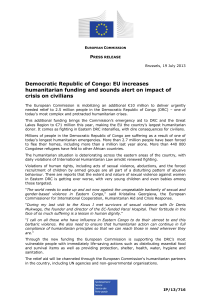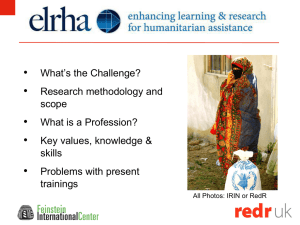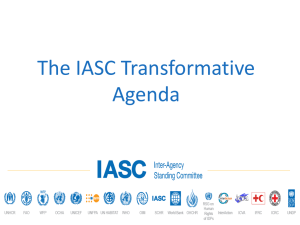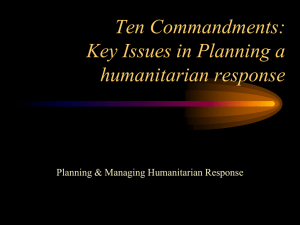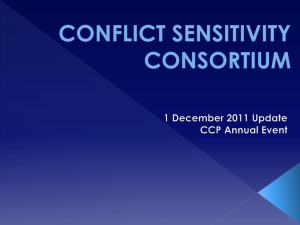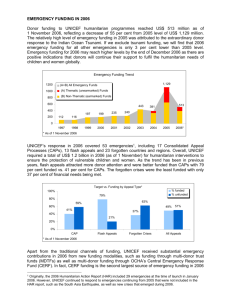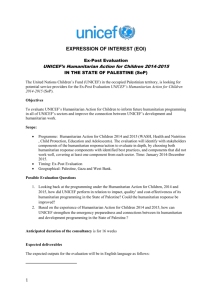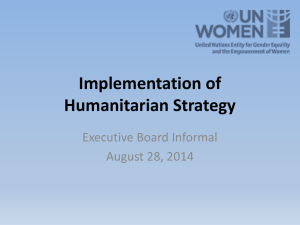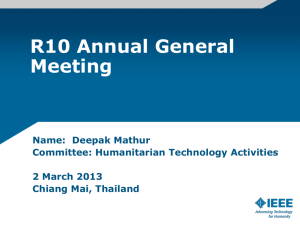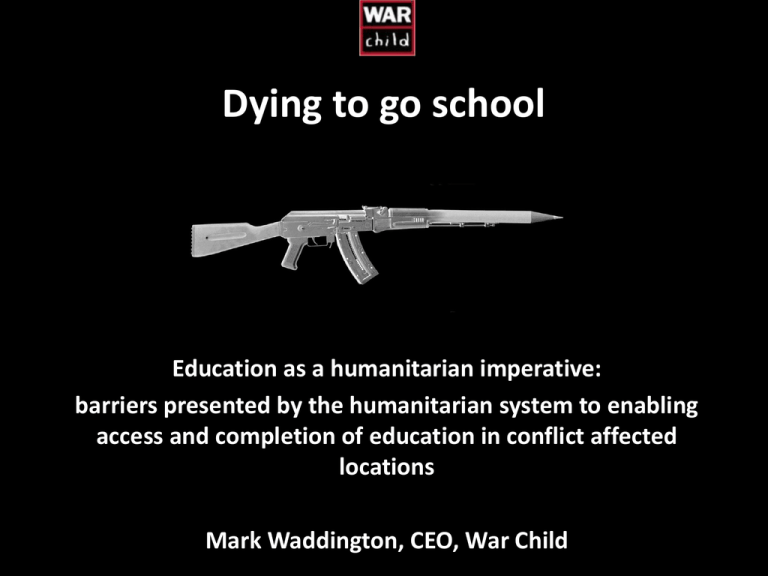
Dying to go school
Education as a humanitarian imperative:
barriers presented by the humanitarian system to enabling
access and completion of education in conflict affected
locations
Mark Waddington, CEO, War Child
Education is a means of survival
1.
In conflict affected locations primary education is often of poor quality, regularly
disrupted and is rarely completed
2.
Consequently, many children are not able to reach a sustainable level of literacy
3.
This has a direct impact on infant mortality because a child born to an illiterate
mother is 50% more likely to die before their 5th birthday than a child born to a
literate mother (3)
4.
In DRC one in five children die before their fifth birthday (4)
Street boys in
eastern DRC where
War Child supports
women to develop
income generating
initiatives so they
can afford the
school fees for their
children
Education is a means of protection
1.
Enabling access to education is an
opportunity to provide safe spaces
which narrow the window of risk
faced by children
2.
Education also provides information
which enables children to protect
themselves
3.
Education can provide psycho-social
support which in a conflict setting
can prevent children from
involvement in high risk behaviours
such as early sex, drugs, and crime
Education is a means of addressing
poverty
1.
Studies show that one year of education can raise the living wage of men and
women by an average of 10% (5)
2.
And because children who have gone to school are more likely to send their
own children to school education helps to address the inter-generational
transmission of poverty (6)
Education can help prevent conflict
1.
Education can make a significant
contribution to economic growth
over time (7)
2.
Paul Collier’s research (8) suggests
that a conflict affected country
which achieves 1% growth pa is
1% less likely to lapse into conflict
3.
So enabling sustained access to
and completion of education can
actually make a significant
contribution to the prevention of
conflict
Access to education is possible in
conflict affected locations
• War Child is successfully:
– Supporting community run pre-school
projects in Afghanistan
– Working alongside the Ministry of Education
in Iraq to rehabilitate schools and train
teachers
– Providing safe spaces for informal learning in
Central African Republic
– And working with local authorities to
promote access to education in the
challenging environment of Karamoja District
in North East Uganda
9 July 2010
Department of
General Assembly
Public
Information • GA/10964
News and
Media Division
• New York
Sixty-fourth General Assembly
Plenary
106th Meeting (PM)
GENERAL ASSEMBLY ADOPTS LANDMARK
RESOLUTION CALLING ON STATES TO
ENSURE RIGHT
TO EDUCATION FOR AFFECTED
POPULATIONS IN ALL PHASES OF
EMERGENCY SITUATIONS
“Deeply concerned over the
inadequate level of funding
for international education
goals and that the education
sector was among the most
under-funded sectors in
humanitarian consolidated
and flash appeals ….. the
message ….. was
clear: education in
emergencies deserved
attention at the level of
other life-saving needs”
• But if:
– Education is a means of
survival and protection
– It contributes to economic
growth as well as the factors
which prevent conflict
– There are ways of successfully
delivering it in conflict
affected locations
– Donor states are signed up to
a UN resolution that
recognises education as a
humanitarian imperative
• Then why are conflict affected
states still home to 42% (28
million) of all the world’s out of
school primary aged children (9)
Masisi, DRC: a case study
• 83% of all IDPs living in camps in North Kivu are
in Masisi District (10)
• In Masisi Centre alone
– Five camps were established in late
2006/early 2007 and are home to 9,053
children – this is 63.3% of the total
population for these camps (Norwegian
Refugee Council)
– Six spontaneous camps have been
established since, which are home to a
further 9,855 children (estimated from NRC
records)
• Access to education in the established camps is
very low – records are patchy but for Bihito we
know that it is only 4% (NRC)
• Educational provision in the spontaneous camps
is lower
• There is no pre-school provision in any of the
camps
Lubero IDP camp,
Masisi Centre
The state barrier
1.
Government policies are focused
on inputs and outputs rather
than educational outcomes
2.
Military expenditure is prioritised
over expenditure on education
3.
The draft budget for 2011 is
$6.6bn (11) of which some 8%
(12) is allocated to education
which makes the state by far the
largest investor in education. But
a large proportion of this money
is not reaching the schools and
educators
4.
Meanwhile, local authorities do
not want to invest in education in
IDP camps because of a fear of
making them permanent
The donor barrier
1.
In North Kivu, despite 83% of all
IDPs being located in Masisi
District (13) the Pooled Fund is
prioritising funding for other
districts
2.
Several donors have refused to
be part of the Pooled Fund, such
as Canada, leading to a fractured
and uncoordinated approach to
funding
3.
The cluster leads on education,
as well as OCHA, are not
proposing an adequate budget
for education to the CAP
4.
Most donors still do not accept
that education is a humanitarian
imperative
Girl’s previously associated with armed
groups with one of their babies in eastern
DRC at a shelter supported by War Child
Education budgets proposed to the
CAP, as of June 2011
Location
Total CAP
revised
requirements
by country
Budget for
education
Education as
a % of the
total revised
requirements
Total
amount
pledged to
education
Pledge for
education as a
% of what was
asked for it
Somalia
529,520,029
17,728,956 3.3%
4,618,938 26%
Chad
506,429,849
14,023,060 2.8%
700,957 5%
DRC
721,589,589
28,800,000 4%
Sudan
1,711,823,864 134,119,125 7.8%
4,100,142 14%
62,766,134 47%
CAR
129,125,182
4,857,506 3.8%
2,747,937 57%
Pakistan
661,180,978
30,492,675 4.6%
15,832,025 52%
OPT
585,555,658
16,938,320 2.9%
4,607,277 27%
Haiti
915,293,190
34,283,882 3.7%
30,475,215 11%
Average 4.1%
28.3%
http://fts.unocha.org/
The UN barrier
1.
UNICEF is the cluster lead on education
but has prioritised non-food items over
education instead of alongside it
2.
UNHCR is the cluster lead on protection
but do not prioritise education as an
emergency need
3.
In the meantime, governance within
the UN system has to deal with
institutionalised conflicts of interest
that are managed in part by
distributing resources across as many
agencies as possible in a way that
erodes responsiveness to needs on the
ground
The NGO barrier
1.
NGOs and other humanitarian actors rightly
undertake assessments to identify gaps in
provision of education, but do not always
recognise these gaps as the symptoms of
underlying causes
2.
By shifting the spotlight off the state we as
NGOs are, in part, making the lack of access
to education OUR responsibility
3.
Many NGO interventions are dependent on
locally sourced institutional forms of
funding in a humanitarian setting, so when
that funding is withdrawn so too are NGO
services
Informal education:
Congolese hip hop artist Didjak
Munya discusses
HIV/AIDS and protection issues
with street children
Some cautions
• Where there is a lack of planning to ensure
that the learning environment is safe then
it can also serve as:
– A recruitment ground for armed groups
– A basis for sexual violence - sex for
grades is common in schools in many
conflict affected countries
– The means through which educators
express their own feelings via corporal
punishment and other forms of
violence against children which lead to
high drop out rates
– A means of reinforcing extremist views
that can contribute to conflict
Some recommendations
1.
2.
3.
4.
5.
6.
7.
Education needs to be sold as the life-saving right that it is! Education is a
humanitarian imperative and this needs to be recognised throughout the
humanitarian system
Policy frameworks need to focus more on education outcomes, rather than just
on spending
Children are the experts on their own lives and are aware of the barriers to access
and completion so their participation in determining these outcomes within our
programming is crucial
A more significant proportion of government, donor and NGO funding must be
allocated to education, targeting a minimum of 25% or more of the national
budget in conflict affected countries, and this must be aligned to a greater
commitment to coordination
Investment is needed in the governance architecture of education to strengthen
the ability of education ministries to foster the conditions in which duty bearers
are enabled and compelled to deliver education, and held accountable for it
Donors and NGOs need to invest more in their own capability to negotiate and
successfully manage development partnerships with the governments and
authorities within conflict affected countries
Compliance with Treaties, Conventions and Security Council Resolutions in a way
that places greater focus on education needs to be integrated within bi-lateral
and multi-lateral aid agreements, made a central part of diplomacy, and explicitly
rewarded - targeted sanctions should be used in the event of non-compliance
1.
2.
3.
4.
5.
6.
7.
8.
9.
10.
11.
12.
13.
14.
Plan International, The State Of The World’s Girls, 2010
UNICEF, State of the World’s Children, 2011
UNESCO, Education and the Millennium Development
Goals, 2010,
(http://www.unesco.org/fileadmin/MULTIMEDIA/HQ/
ED/GMR/pdf/gmr2010/MDG2010_Facts_and_Figures_
EN .pdf .
UNICEF, State of the World’s Children, 2011
http://www.savethechildren.org.uk/en/docs/Attacks_o
n_schools_brief_final_(2).pdf
Breaking Poverty Cycles – The Importance of Action in
Childhood, CHIP Policy Briefing 8, by Caroline Harper,
2004
Education Quality and Economic Growth, 2007, World
Bank
The Bottom Billion, Why The Poorest Countries Are
Failing And What Can Be Done About It, 2007, Paul
Collier
EFA Global Monitoring Report, 2011, The hidden crisis:
Armed conflict and education
http://www.dc4idp.org/htdocs
www.theafricareport.com
Verbal communication from UNICEF
http://www.dc4idp.org/htdocs
Donors Engagement: supporting education is fragile
and conflict-affected states’, (UNESCO, 2009)
References
Some words should
never go together
Child Prisoner
Child Soldier
War Child
Street Child
War Child
If you want a copy of this presentation or to discuss any of the points
raised in it please drop me a line at:
mark@warchild.org.uk

